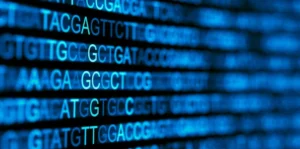JULY 29, 2023
Man’s Best Distant Relative: How Much DNA Do We Share with Dogs?

DNA encodes the shared history of all living things on the planet. As the scientific knowledge surrounding DNA continues to grow, the intricate patterns within this genetic code reveal surprising connections and commonalities across species. Much like genealogists use family trees to trace a person’s ancestry, biologists apply similar principles to uncover the evolutionary relationships between different species.
When comparing the DNA of humans with other species like dogs or primates, surprising similarities emerge. Here, you will learn how much DNA a human shares with dogs, primates, and more.
How Much DNA Do We Share with Dogs?
Man’s best friend is more closely related to humans than you may think. The domestic dog, scientifically classified as Canis lupus familiaris, shares a surprising amount of genetic code with humans – approximately 84%.
Note that the high percentage of shared DNA between humans and dogs does not suggest humans are 84% canine. Instead, it conveys that there are many similarities between the genetic sequences that make up their respective genomes.
The percentage of DNA that two species share is also influenced by how recently they shared a common ancestor. Humans and dogs share a common ancestor that lived approximately 90–100 million years ago.
Canine-Based Cures and Treatments
Considering that humans and dogs share a sizeable percentage of their DNA, they also share many of the same health problems. Doctors have diagnosed cancer, heart disease, diabetes, and mental health problems in both species. When scientists study health problems in dogs and find ways to treat them, their discoveries can help with potential human treatments as well.
Primates: Our Closest Animal Ancestor
When it comes to the living beings with which humans share the most DNA, the chimpanzee (Pan troglodytes) prevails. The DNA of humans and chimpanzees is 98.8% identical. This statistic underscores a close evolutionary relationship, which is evident when you look at how similar a primate’s features are to a human’s.
Although other primates may not possess the same degree of genetic similarity to humans as chimpanzees do, their genetic proximity is still substantial. For example, the DNA of humans and orangutans is about 97% identical.
Primate-Based Cures and Treatments
Primates have played a crucial role in the development and testing of cures and treatments for diseases that can affect humans. Some primate-based cures and treatments that have been conceived or studied include:
- Vaccines
- Drug Development
- Gene Therapy
- Behavioral and Psychological Studies
- Surgical Techniques and Transplantation
Because humans and primates are so similar genetically, studying their immune response and efficacy to specific treatments can lead to valuable insights for potential effectiveness in humans.
Percentage of DNA Shared with Humans by Species
Our DNA connects us not just to dogs, primates, and other mammals but to living beings of all varieties.
| Species | Percentage of DNA Shared with Humans |
| Chimpanzee (Pan troglodytes) | 98.8% |
| Orangutan (Pongo pygmaeus) | 97% |
| Cat (Felis catus) | 90% |
| Dog (Canis lupus familiaris) | 84% |
| Acorn Worm (Enteropneusta) | 70% |
| Fruit Fly (Drosophila melanogaster) | 60% |
Sources: American Museum of Natural History, National Institutes of Health, National Library of Medicine, Seattle PI, Smithsonian Magazine, Pfizer
Get Connected with DNA Testing
Whether you are testing for paternity, tracing your ancestry, or verifying your dog’s parentage, DNA can offer more than just practical knowledge. It can also provide you with some insight into how connected all living things are.
About DNA Diagnostics Center (DDC)
DNA Diagnostic Center is the world leader in paternity and relationship testing. We serve healthcare professionals, government agencies, and individuals around the world to determine family relationships with trusted accuracy.
More Questions? Don’t hesitate to call us: we’re here to help!
CALL NOW




